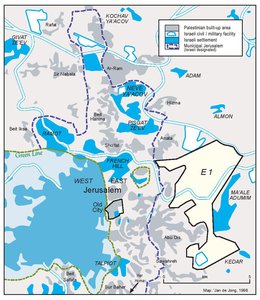THE E-1 DEVELOPMENT PLAN
Map Details
Realization of Israel’s vision of a ‘united’ Jerusalem with comprehensive Jewish territorial and demographic preponderance from west to east hinges on its success in divesting the occupied east of its Palestinians and in increasing the settlement population within and around the municipal area. Taking possession of, or exercising control over, the essential resource of the city – its land – is Israel’s most important tool in redesigning the city’s ethnic makeup to suit its purposes.
Beyond the city’s municipal limits, Israel has founded a circle of large urban ‘city-settlements’ to encapsulate the annexed East and stretch its potential boundaries. These sites, connected by bypass roads and linked to industrial zones, form Israel’s ‘outer ring’ of Jerusalem settlements, and provide the infrastructural support for the settlements lying deeper in the West Bank – around Ramallah, Bethlehem and Jericho.
Among them is the Ma’ale Adumim settlement, the borders of which were expanded in 1994 to include the E-1 area: a narrow undeveloped land corridor that runs east of Jerusalem and is part of the West Bank (Area C). The area is bordered by the settlements of French Hill (to the west), Kedar (south), Ma'ale Adumim (east), and Almon (north), and the Palestinian town of Abu Dis to the southwest. Here, Israel envisions the E-1 Plan, a large new Israeli neighborhood (Mevasseret Adumim) involving about 12,000 dunums of land, a significant part of which is privately owned by Palestinians. So far, all successive Israeli governments have supported the plan to create Israeli urban contiguity between Ma’ale Adumim and Jerusalem but have also refrained from implementing any major construction – in accordance with an understanding with the US Administration that the fate of the area would be determined within the framework of the peace process, and due to international pressure.
While the E-1 Plan was, for the time being, removed from the agenda for political reasons, a project by the Ministry of Industry and Trade for a metropolitan employment and business center serving both Ma'ale Adumim and the Jerusalem municipality on 1,350 dunums in the north-west section of E-1, was approved in 2002 but has yet to be implemented. In mid-2004, the Sharon Administration commenced infrastructural work such as clearing roads. Another plan for the construction of the new 'Judea and Samaria District Police' headquarters on 180 dunums was approved in 2005 and completed in 2008. It is widely seen as a strategic step in claiming the area for further Jewish development.
Since then, the E-1 plan regularly makes headlines but so far no Israeli government has dared to give it a final go ahead, mainly due to international pressure to refrain from it. In response to UNGA Resolution 67/19 of 29 November 2012, upgrading Palestine to non-member observer state status in the UN, Israel announced that it was resuming planning and zoning work in E-1 area, which was protested by several EU governments.
With E-1, Israel unveiled a scheme to unite the West Bank’s largest and most central settlement (Ma’ale Adumim) with its East Jerusalem ‘inner ring’ sites by means of a residential, industrial and ‘recreational’ development project. The E-1 Plan foresees between 3,500-15,000 housing units, the already completed police headquarters of the ’Judea and Samaria district’, a large industrial zone, an expansive tourism infrastructure, including several hotels, and commercial areas, as well as roads, a garbage dump and a cemetery.
Israel claims that the E-1 plan is strategically important for its national security interests, especially with regard to Jerusalem and the Ma’ale Adumim settlement, as well as for the natural growth of the latter. Palestinians – backed by the UN, US and EU – vehemently oppose the plan, saying that if implemented, it would cut the West Bank in two, grab the last area of open land available for Palestinian development, and make the establishment of a Palestinian state with territorial contiguity as well as an agreement on permanent borders practically impossible.
Related Maps
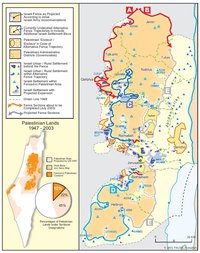
ISRAEL'S SEPARATION BARRIER, 2002
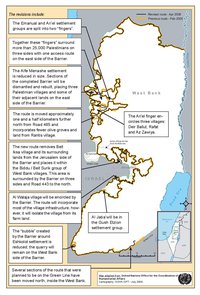
REVISED ROUTE OF THE ISRAELI SEPARATION BARRIER, 2006
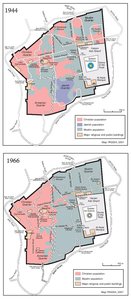
THE OLD CITY, 1944 & 1966

MUNICIPAL BOUNDARIES OF JERUSALEM, 1947-2000
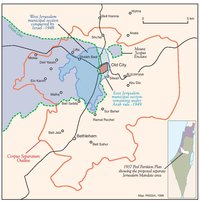
JERUSALEM AND THE CORPUS SEPARATUM PROPOSED IN 1947
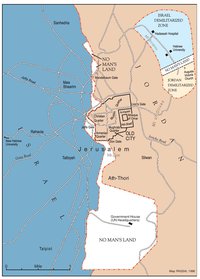
PARTITIONED JERUSALEM, 1948-1967
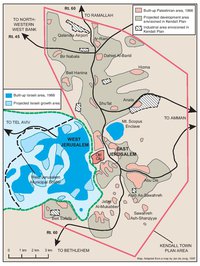
THE KENDALL TOWN SCHEME, 1966
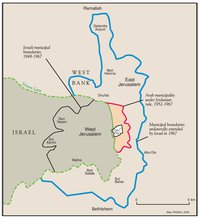
JERUSALEM AFTER THE 1967 WAR
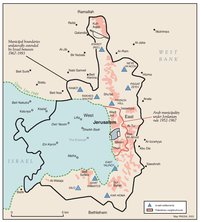
ISRAELI SETTLEMENTS AND PALESTINIAN NEIGHBORHOODS IN EAST JERUSALEM, 2000
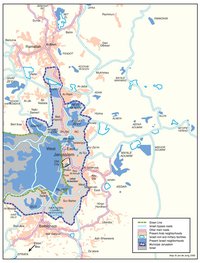
ISRAELI SETTLEMENTS AND PALESTINIAN NEIGHBORHOODS IN METROPOLITAN JERUSALEM, 2000
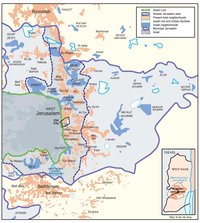
ARAB EAST JERUSALEM WITHIN ‘GREATER’ JERUSALEM, 2000

PROJECTION OF THE ISRAELI PROPOSAL FOR JERUSALEM’S FINAL STATUS AT CAMP DAVID, JULY 2000
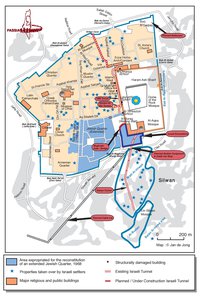
SETTLEMENT ACTIVITY IN THE OLD CITY
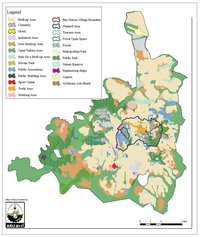
THE JERUSALEM MASTER PLAN
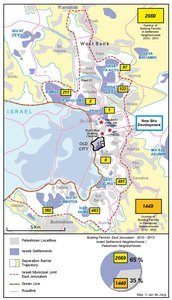
JERUSALEM TODAY (2014)


